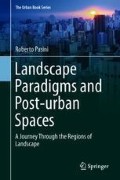Abstract
‘Symbiotic field’ refers to the space, topos and chora or locus and spatium, where natural and artificial systems intersect, producing the multilayered construct of landscape. Throughout this essay, we will resort to a series of established concepts proceeding from sources diverse in location and time across the geographic configuration of the multidisciplinary debate on landscape to enumerate components of a possible construct. That construct is meant to be climbed upon and then thrown away like Wittgenstein’s ladder, which we may call here the ‘ladder of Rome’, as we are discussing matters related to urbanity.
Access this chapter
Tax calculation will be finalised at checkout
Purchases are for personal use only
Notes
- 1.
This metabolist terminology more simply refers to the ‘manmade’ and ‘natural’.
- 2.
See the ‘A corollary note to the Introduction’ at the end of this section.
- 3.
The term contrade, used by Piero Camporesi in his book Le belle contrade about the ‘birth of Italian landscape’, is evocative of the transition from a medieval to a modern entendement of a land entity that could be translated as ‘shires’. Camporesi asserts that the notion of landscape in the Cinquecento was that of the ‘paese’, somewhat correspondent to today’s notion of territory. See further elaboration on this central issue in Chaps. 2 and 7 of this book.
- 4.
We have reconstructed in previous publications, the formation of the conventional notion of ‘cultural landscape’ until its adoption by the highest international institutions, among others UNESCO. Further articulations of the terminology referring to landscape are being coined at sustained pace, such as the notion of ‘cultural routes’ introduced by the Council of Europe. See: the European Landscape Convention of the Council of Europe, Florence 2000; Roberto Pasini, ‘Triclini sul mare e rotte culturali’, in: Graphie n. 66, 2014; Eleonora Berti, Itinerari culturali del Consiglio d’Europa tra ricerca di identità e progetto di paesaggio, Firenze University Press 2012.
- 5.
Examples are, respectively, the National Ecological Security Pattern, recently adopted by the Chinese government to secure survival of the national territorial system undergoing an unprecedented anthropic pressure and the Air Trees, cyborg-trees designed to reintroduce environmental quality in the metropolitan periphery of Madrid.
- 6.
In ‘Journey Through the Picturesque (a Notebook)’, I-ñaki Ábalos and Juan Herreros present “hybrid models [generated by] the interaction between natural and artificial materials” as the basis for a ‘new naturalism’ that replaces public space with a “hybrid, crossbred, entropic, humanized conglomerate” (Ábalos and Herreros 2003, pp. 56–57).
- 7.
The symbiotic necessity is a by-consequence of human species’ self-proclaimed emancipation from the animal state evoked by calling the product of its own actions artificial, that is, nonnatural.
- 8.
The matorral submontano is a low, dense ecosystem of great diversity. See relative note in Preface and Chap. 8 of this book.
References
Ábalos I, Herreros J (2003) Journey through the picturesque (a notebook). In: Mostafavi M, Najle C (eds) Landscape urbanism: a manual for the machinic landscape. Architectural Association, London
Böhme G (2006) Atmosphere as the subject matter of architecture. In: Ursprung P (ed) Natural histories. Lars Müller, Zurich
Baccini P, Brunner P (2012) Metabolism of the anthroposphere. The MIT Press [1991]
Berti E (2012) Itinerari culturali del Consiglio d’Europa tra ricerca di identità e progetto di paesaggio. Firenze University Press, Firenze
Camporesi P (2016) Le belle contrade. Nascita del paesaggio italiano. Il Saggiatore, Milano [1992]
D’Angelo P (2010a) Estetica Ambientale. Enciclopedia Treccani. Istituto dell’Enciclopedia Italiana, Roma
Eco U (1984) The name of the rose (trans: Weaver W). Warner Books [1980]
Montaner JM (2000) Espacio. In: de Solá-Morales I (ed) Introducción a la Arquitectura. Ediciones UPC, Barcelona
Pasini R (2014) Triclini sul mare e rotte culturali. Graphie (Il Vicolo) (66)
Pepin R (1986) Adso’s closing line in the name of the rose. Am Notes Queries 24:9–10
Rossi A (1982) The architecture of the city. The MIT Press, Cambridge [1966]
Sauer CO (1925) The morphology of landscape. Univ Calif Publ Geogr 2:19–53
Tunnard C (1978) A world with a view. Yale University Press, An Inquiry into the Nature of Scenic Values. New Haven
Tunnard Ch, Pushkarev B (1963) Man-made america: chaos or control?. Yale University Press, New Haven
Wittgenstein L (2010) Tractatus logico-philosophicus. Introduction by Bertrand Russell (trans Ogden CK). Project Gutenberg [1921]
Legal Notice:
Fig. 1.1: Unknown (https://commons.wikimedia.org/wiki/File:Neuschwanstein_Castle_LOC_print.jpg), „Neuschwanstein Castle LOC print“, marked as public domain, more details on Wikimedia Commons: https://commons.wikimedia.org/wiki/Template:PD-1923
Author information
Authors and Affiliations
Corresponding author
Rights and permissions
Copyright information
© 2019 Springer International Publishing AG, part of Springer Nature
About this chapter
Cite this chapter
Pasini, R. (2019). Introduction: Defining a Symbiotic Field. In: Landscape Paradigms and Post-urban Spaces. The Urban Book Series. Springer, Cham. https://doi.org/10.1007/978-3-319-77887-7_1
Download citation
DOI: https://doi.org/10.1007/978-3-319-77887-7_1
Published:
Publisher Name: Springer, Cham
Print ISBN: 978-3-319-77886-0
Online ISBN: 978-3-319-77887-7
eBook Packages: Earth and Environmental ScienceEarth and Environmental Science (R0)

